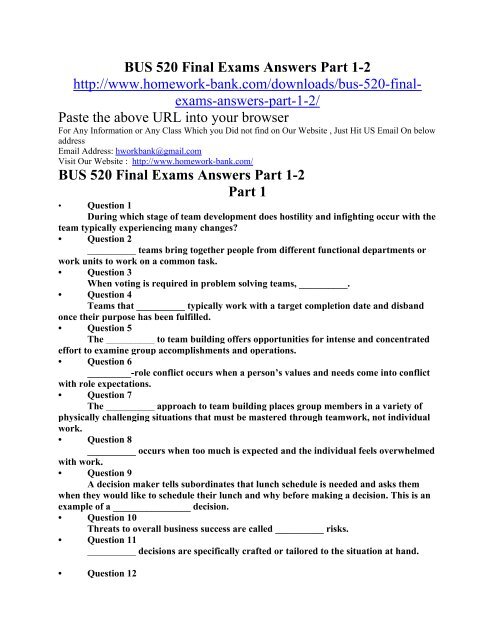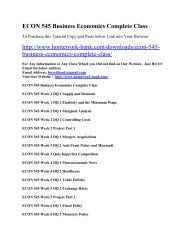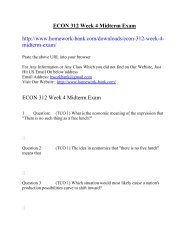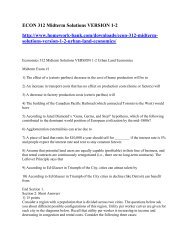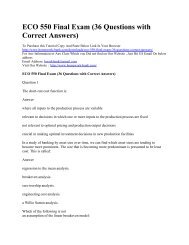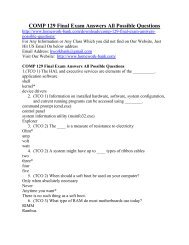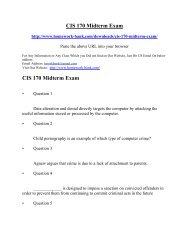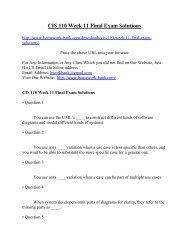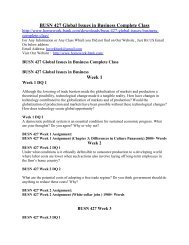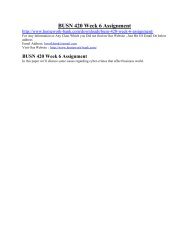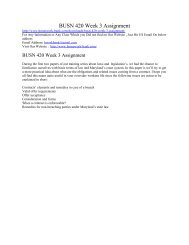o_19i2p1hv011ah1g4u1kjb1iu01blj2h.pdf
For Any Information or Any Class Which you Did not find on Our Website , Just Hit US Email On below address Email Address: hworkbank@gmail.com Visit Our Website : http://www.homework-bank.com/
For Any Information or Any Class Which you Did not find on Our Website , Just Hit US Email On below address
Email Address: hworkbank@gmail.com
Visit Our Website : http://www.homework-bank.com/
Create successful ePaper yourself
Turn your PDF publications into a flip-book with our unique Google optimized e-Paper software.
BUS 520 Final Exams Answers Part 1-2<br />
http://www.homework-bank.com/downloads/bus-520-finalexams-answers-part-1-2/<br />
Paste the above URL into your browser<br />
For Any Information or Any Class Which you Did not find on Our Website , Just Hit US Email On below<br />
address<br />
Email Address: hworkbank@gmail.com<br />
Visit Our Website : http://www.homework-bank.com/<br />
BUS 520 Final Exams Answers Part 1-2<br />
Part 1<br />
• Question 1<br />
During which stage of team development does hostility and infighting occur with the<br />
team typically experiencing many changes?<br />
• Question 2<br />
__________ teams bring together people from different functional departments or<br />
work units to work on a common task.<br />
• Question 3<br />
When voting is required in problem solving teams, __________.<br />
• Question 4<br />
Teams that __________ typically work with a target completion date and disband<br />
once their purpose has been fulfilled.<br />
• Question 5<br />
The __________ to team building offers opportunities for intense and concentrated<br />
effort to examine group accomplishments and operations.<br />
• Question 6<br />
_________-role conflict occurs when a person’s values and needs come into conflict<br />
with role expectations.<br />
• Question 7<br />
The __________ approach to team building places group members in a variety of<br />
physically challenging situations that must be mastered through teamwork, not individual<br />
work.<br />
• Question 8<br />
__________ occurs when too much is expected and the individual feels overwhelmed<br />
with work.<br />
• Question 9<br />
A decision maker tells subordinates that lunch schedule is needed and asks them<br />
when they would like to schedule their lunch and why before making a decision. This is an<br />
example of a ________________ decision.<br />
• Question 10<br />
Threats to overall business success are called __________ risks.<br />
• Question 11<br />
__________ decisions are specifically crafted or tailored to the situation at hand.<br />
• Question 12
The first step in the rational decision model is _______________.<br />
• Question 13<br />
The most difficult environment for decision makers to cope with is the __________<br />
environment.<br />
• Question 14<br />
__________ involves interpersonal difficulties that arise over feelings of anger,<br />
mistrust, dislike, fear, resentment, and the like.<br />
• Question 15<br />
Conflict between functional departments such as marketing and manufacturing is a<br />
common example of __________.<br />
• Question 16<br />
__________ occurs when a formal authority simply dictates a solution and specifies<br />
what is gained and what is lost by whom.<br />
• Question 17<br />
__________ commonly involves supervisor-subordinate disagreements over<br />
resources, goals, deadlines, or performance results.<br />
• Question 18<br />
The term __________ is sometimes used to describe rudeness in electronic<br />
communication.<br />
• Question 19<br />
The success of international business practices such as outsourcing often rests with<br />
the quality of __________.<br />
• Question 20<br />
The open and honest sharing of information is known as __________.<br />
• Question 21<br />
When in doubt regarding the clarity of your written or spoken message, the<br />
recommended course of action to follow is:<br />
• Question 22<br />
The __________ is an unwritten set of expectations about a person’s exchange of<br />
inducements and contributions with an organization.<br />
• Question 23<br />
In building on the Machiavellian tradition, managers are often considered<br />
__________ when they seek their own goals or use means that are not currently authorized<br />
by the organization or that push legal limits.<br />
• Question 24<br />
Managers derive power from both organizational and individual sources, which are<br />
called __________.<br />
• Question 25<br />
Which strategy for exercising relational influence can be described as “using the<br />
exchange of benefits as a basis for negotiation?”<br />
Part 2<br />
• Question 1<br />
The role of __________ is to promote adaptive or useful change.
• Question 2<br />
Meindl referred to the phenomenon whereby people attribute almost magical<br />
qualities to leadership as _____________.<br />
• Question 3<br />
__________ is exerted by persons appointed to or elected to positions of formal<br />
authority in organizations.<br />
• Question 4<br />
__________ is the process of influencing others to understand and agree about what<br />
needs to be done and how to do it, and the process of facilitating individual and collective<br />
efforts to accomplish shared objectives.<br />
• Question 5<br />
The __________ to studying leadership sought to identify important differences<br />
between leaders and non-leaders.<br />
• Question 6<br />
“Know thyself” is the essential argument of __________ leadership.<br />
• Question 7<br />
People respond to a(n) __________ change strategy mainly out of the fear of being<br />
punished if they do not comply with a change directive or out of the desire to gain a reward<br />
if they do.<br />
• Question 8<br />
A key similarity shared by ethical, authentic, spiritual and transformational<br />
leadership is __________.<br />
• Question 9<br />
__________ represent(s) forces for change that deal with mergers, strategic<br />
alliances, and divestitures as ways of redefining organizational relationships with<br />
challenging social and political environments.<br />
• Question 10<br />
The leadership context of __________ refers to a dramatic departure from prior<br />
practice and sudden threats to high-priority goals with little or no response time.<br />
• Question 11<br />
Organizations are encouraged to develop a dominant and coherent set of<br />
__________. Although every member may not agree with them, all members will know they<br />
are important.<br />
• Question 12<br />
The five-step program for developing the multicultural organization was developed<br />
by __________.<br />
• Question 13<br />
__________ involves reaching goals and dealing with outsiders.<br />
• Question 14<br />
To many researchers and managers, shared common values lie at the heart of<br />
organizational __________.<br />
• Question 15<br />
Which step in the innovation process focuses on establishing an idea’s potential<br />
value and application?
• Question 16<br />
The major advantages of the __________ pattern are its flexibility in meeting<br />
external demands, spotting external changes, integrating specialized individuals deep<br />
within the organization, and focusing on the delivery of specific products to specific<br />
customers.<br />
• Question 17<br />
__________ statements are written statements of organizational purpose, which may<br />
include corporate ideas of service to society.<br />
• Question 18<br />
__________ is the degree to which the authority to make decisions is delegated to<br />
lower levels in an organization’s hierarchy.<br />
• Question 19<br />
__________ are work groups that conduct the major business of the organization.<br />
• Question 20<br />
__________ methods of coordination produce synergy by promoting dialogue,<br />
discussion, innovation, creativity, and learning, both within and across organizational<br />
units.<br />
• Question 21<br />
A research and development laboratory is an example of __________ technology.<br />
• Question 22<br />
In many organizations, the initial implementation of __________ displaces the most<br />
routine, highly specified, and repetitious jobs but it did not alter the fundamental character<br />
or design of the organization.<br />
• Question 23<br />
Successful organizations arrange their __________ to meet the dictates of their<br />
dominant technologies or workflows and information technology opportunities.<br />
• Question 24<br />
Environmental uncertainty and volatility can be particularly damaging to<br />
__________.<br />
• Question 25<br />
Joan Woodward’s three categories of technology include __________.


